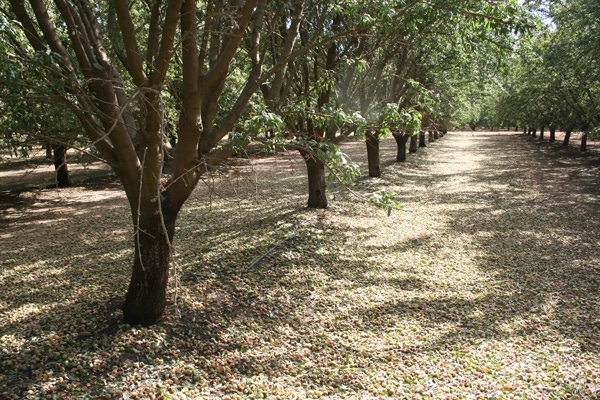
Grinding up entire almond orchards and incorporating the woody biomass into the soil is having positive impacts on soil quality and possibly carbon sequestration.
Research launched seven years ago by farm advisor Brent Holtz, University of California Cooperative Extension San Joaquin County, now reveals that nutrients in wood are slowly released over time and provide a healthy growing environment for young trees.
Holtz recently received a $145,000 grant from Almond Board of California (ABC), plus funds through a Specialty Crop Block Grant from the California Department of Food and Agriculture and the USDA, to explore the feasibility of whole almond orchard recycling at additional sites and under different conditions.
To date, he says soil analyses of orchard recycled sites and the health of second-generation almond trees to date is yielding evidence that the practice mimics the ultimate sustainable system - Mother Nature.
This news comes as almond orchard removal is expected to peak in the next few years. Holtz says 50,000 to 60,000 acres of almond trees per year could be pushed out of the ground due to age.
The standard practice of tree removal is to pull the trees, grind them on-site, and haul the wood to a co-generation plant as tighter air quality rules in the San Joaquin Valley has limited the option to burn waste. Burning restrictions and fewer active co-generations plants are leaving growers with fewer cost effective options for orchard removal.
An almond Life Cycle Assessment conducted by UC Davis suggests that almond trees accumulate and store significant amounts of carbon during their 25-30 year life span.
Incorporating wood back into the soil where carbon is gradually released by soil microbes likely extends the carbon sequestration. It also reduces greenhouse gas emissions and ultimately the crop’s carbon footprint.
In future projects, researchers hope to measure the greenhouse gas sequestration potential.
Gabriele Ludwig, ABC’s director of Sustainability and Environmental Affairs, says Holtz’s initial research shows replanted trees performed well where woody biomass is incorporated into the soil if fertilized normally.
No stunting of second-generation almond trees was noted. However, part of the point of the additional locations is to see if this is repeated.
Holtz observed that when the woody biomass from grinding is incorporated into the soil it was rapidly colonized by fungal mycelium, yet it can take several years to see actual changes in the soil.
In addition, the decomposition of the woody biomass may be contributing to available nutrient levels matching the increased nutrient demand as young trees enter bearing production.
In the initial 2010 trial, Ludwig says they found lower levels of harmful salts, increased soil organic matter, and improved water holding capacity where wood chips were incorporated after grinding.
In comparison plots, the removed trees were burned and the ash incorporated. Two summers ago, the improved water-holding capacity was demonstrated, as the site was inadvertently not irrigated for 60 days, says Ludwig. Stem water potential measurements on the trees were 5-8 bars higher than trees planted in plots where the previous trees were burned.
Ludwig says increased organic matter in the soil will lead to a more diverse soil microbe population yet the benefits will take time to realize.
“Our hope is that it will repress soil pests and diseases and nematodes,” she says. “We have no current data, but are looking into this.”
The new projects will include a team of researchers with a range of skill sets including nematology, plant pathology, and soil chemistry.
In Holtz’s research, he is assessing the costs and benefits of different methods of grinding up trees to incorporate the wood chips into the soil.
Last year, a demonstration of the 50-ton rock crush called the “Iron Wolf” showed growers the entire tree removal process in one pass - pushing, grinding, and incorporation. The machine can average about three-to-four acres of trees in an eight-hour day.
Ludwig says the expense of a single machine and its slow speed are drawbacks. Also, the grinding was not uniform, leaving some larger chunks of wood.
Holtz is examining the standard tub grinding process, which produces smaller, more uniform sized chips. The chips are spread on the ground and incorporated with modifications of existing farm equipment.
About the Author(s)
You May Also Like




